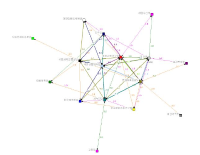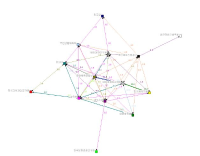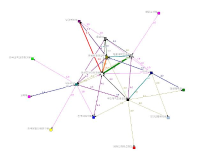
The purpose of this study was to investigate structural characteristics and participants` roles & functions of sport policy network in Korea, by social network analysis on structural characteristics of sport policy network and AHP analysis on participants` roles and functions. For that, 21 executive officers from 19 organizations and agencies related to sports policy were selected as study subjects, and, the materials collected from whole twice surveys on them were analysed by Ucinet 6 and Expert Choice 2000 program. As the results, the governmental organizations like the Blue House and Ministry of CultureㆍSports and Tourism composed the central position group of sport policy network of Korea, and took the main functions of planing and arrangement within their main roles of policy agenda formation and policy decision, so, sport policy network of Korea could be called centralized network by government. And, in cases of private agencies, Korea Sports Council composed the central position group only in policy network of professional sport, Korea Council of Sport for All of sport for all, and Korea Sports Association for the Disabled of disability sport, and, each of them took the main roles and functions of policy execution in their fields, so, it was obvious that the private agencies were divided into their own sport policy areas.




PURPOSE This study aimed to present the measures necessary to perform well in tennis clubs by examining the adaptation process of the MZ generation participating in tennis clubs. METHODS A qualitative case study was performed and data was collected through in-depth interviews, direct observations, and literature surveys. The data were analyzed by applying pattern matching among the analysis methods proposed by Yin (2014), and the reliability and validity of the study were demonstrated by consultations between colleagues, reviewing members, and comparing and analyzing previous studies. The study participants were seven MZ generation tennis club participants selected through snowball sampling (one of the non-probability samples). RESULTS Achieving a level of skill that allows for compatibility and the effort required for it, the acceptance of differences in club culture and between generations, having the etiquette necessary for Generation MZ, and falling for the charm of tennis itself were identified as factors for successful participation in tennis clubs. CONCLUSIONS This study is expected to help the MZ generation, who have recently been interested in tennis, continue their participation, as well as lay a small foundation for the expansion of the base of the sport by detailing the measures necessary to successfully participate in tennis clubs.

The purpose of this study is to examine the level and difference of sport personalitys of middle school students depending on their quality of sport participation. According to prior research(박정준, 2012; Beller & Stoll, 1996), we decided that faithfulness, cooperation, justice and consideration are the sub-components of sport personalities. The reliability and validity of the Sport Personality Index Questionnaire was verified through Cronbach's α test and confirmatory factor analysis. The survey was conducted from students (n=768) in an urban area of Seoul, thereby level and differences of sport personality were analysed by t-test, one-way ANOVA, and frequency analysis. As a result, male students had higher sport personalitys than female, with regard to the participants'grade, frequency and duration of sports involvement. Disparities of gender and grade were revealed due to the frequency and duration of their sports participation. Regarding the effectiveness of sports activities, school-directed sports activities such as the after school sports programs or mandatory sports club activities had barely influenced building sport personality. In order to build students'sports personalities, specific strategies are sorely needed to increase girl's participation and to enlarge opportunity for regular and consistent participation of middle school students. Moreover, in order to develop participants'sport personality within school-directed sports activities, those programs'development and implementation should be deliberately approached with pedagogical intention and organization.


PURPOSE With participants in recreational sports clubs, this study clarified positive psychological capital’s mediating effect on the relationship between exercise commitment and perceived stress. METHODS A survey conducted with individuals actively engaged in recreational sports a yielded data for statistical analysis from 296 respondents. Data processing involved frequency analysis, confirmatory factor analysis, reliability analysis, correlation analysis, structural equation modeling, and testing for mediating effects using the SPSS 29.0 and AMOS 29.0 programs. RESULTS First, results showed that exercise commitment did not significantly impact perceived stress. Second, exercise commitment positively influenced positive psychological capital. Third, positive psychological capital negatively impacted perceived stress. Fourth, positive psychological capital mediated completely between exercise commitment and perceived stress. CONCLUSIONS This research encourages participation in physical activities, especially among those with low physical activity levels, because it positively affects both physical and mental well-being, ultimately enhancing social benefits and overall quality of life.
PURPOSE This study examined levels of safety knowledge and practice among recreational sports participants, focusing particularly on impacts of gender, age, injury experience, and exercise-level profile. In sports environments, understanding these factors is essential for developing targeted strategies to promote safe behaviors. METHODS Survey data from 7725 participants engaged in regular recreational sports activities were analyzed. Latent Profile Analysis was employed to categorize participants based on their injury experience and exercise levels, resulting in two profiles: Group 1 (moderate or severe injury experience with intermediate exercise levels) and Group 2 (mild injury experience with beginner exercise levels). Three-way ANOVA was then used to evaluate relationships between these profiles and safety knowledge and practice levels. RESULTS Results revealed significant differences across sex, age, and profile groups. Compared with women, men demonstrated higher levels of safety knowledge and practice, which were likely influenced by greater exposure to high-intensity sports and risk-taking tendencies. Adolescents exhibited the highest levels of safety knowledge and practice linked to structured safety education, but these levels declined in early adulthood and then increased again in middle age due to growing health awareness and preventive motivations. Furthermore, participants in Group 1 consistently showed higher levels of safety knowledge and practice than those in Group 2, highlighting injury experience’s role in shaping safety behaviors. CONCLUSIONS These findings underscore the importance of developing gender-specific safety education programs, age-appropriate interventions, and training initiatives tailored to beginning participants. Future research should evaluate these strategies’ long-term impact on safety practices and injury prevention in diverse sports settings.
PURPOSE This study aimed to verify the differences in anticipated regret and gambling discontinuance intent based on the fear appeal type and source similarity in different types of horse-racing gamblers. METHODS Using convenience sampling, 172 responses were collected from horse-racing participants who bought horseracing tickets within the last 6 months. After eliminating 30 insincere responses, descriptive, correlation, reliability, and two-way multivariate covariance analyses were conducted using SPSS Ver. 26.0. RESULTS Anticipated regret and discontinuance intent were higher under fear appeal using social compared with financial risk. Compared to recreational gamblers, problem gamblers had higher anticipated regret and discontinuance intent under fear appeal using social compared with financial risk. There were no differential impacts of source similarity on anticipated regret and discontinuance intent in both types of gambler. CONCLUSIONS Practitioners in charge of conducting messaging campaign to prevent addiction to horse-racing gambling may cause problem gamblers to expect regret and quit gambling by delivering preventive messages with relatively unfamiliar risks such as social risks, rather than familiar risks such as financial ones.
PURPOSE Sporting events constitute attractive platforms for providing participants with unique experiences. This study was aimed at investigating the structural relationships among perceived sporting event quality, image, trust, satisfaction, and loyalty of small-scale golf tournament participants. METHODS The questionnaire was structured in five dimensions: sporting event quality (4 sub-dimensions and 13 items), image (3 items), trust (3 items), satisfaction (3 items), and loyalty (4 items). A total of 217 amateur golfers from four Ecolian public golf clubs (Gwangsan, Jechon, Jeoungsun, and Younggwang) during the golf tournament participated in this study. Factor, reliability, validity, and structural equation model analyses were performed utilizing SPSS 24.0 and AMOS 24.0. RESULTS This study indicated that sporting event quality in a small-scale sporting event was the crucial factor of image, trust, and satisfaction, which, in turn, significantly impacted loyalty. CONCLUSIONS The results of this study contribute to theoretical understandings of sporting event quality factors that predict sport consumers’ image, trust, and satisfaction in the context of sports and leisure. Additionally, this study offers practical suggestions for administrators who develop marketing strategies for small-scale sporting events.
Purpose The aim of this study was to examine how middles school students in physical education class perceived relations between parental and teacher’s autonomy support, enjoyment, self-efficacy, academic effort, and P · E class flow. This study also investigate the mediating effects of enjoyment, self-efficacy, and academic effort on the relations between parental autonomy support and P · E class flow and between teacher’s autonomy support and P · E class flow. Methods For this study, 323 middle school students completed surveys to measure their perceptions of parental and teacher’s autonomy support, enjoyment, self-efficacy, academic effort, and P · E class flow. SPSS 24.0 was used to calculate descriptive statistics, reliability, and correlations. Amos 22.0 was utilized for confirmatory factor analysis, convergent validity, discriminant validity, and structural equation modeling. Additionally, 2000 bootstrap samples were requested for the mediation effect analysis. Results First, parental autonomy support was positively predictive of enjoyment and self-efficacy. Second, teacher’s autonomy support positively influenced enjoyment and self-efficacy. Third, enjoyment and self-efficacy positively affected academic effort. Forth, academic effort was positively related to P · E class flow. Fifth, there were partial mediating effects of enjoyment, self-efficacy, and academic effort on the relationship between parental autonomy support and P · E class flow. Lastly, there were partial mediating effects of enjoyment, self-efficacy, and academic effort on the relationship between teacher’s autonomy support and P · E class flow. Conclusions The study found that teachers' autonomy support was stronger predictive of student’s P · E class flow in physical education class than parent's autonomy support was. The finding is meaningful in that it is worth providing and utilizing practical knowledge from an educational perspective.
PURPOSE Taekwon gymnastics is expected to be a program that can overcome the management difficulties currently faced by Taekwondo gyms and contribute to the expansion of Taekwondo base. Therefore, this study aimed to examine the relationship among organizational identification, flow experience, intention to continue participation, and recommendation intention of Taekwon gymnastics participants. METHODS In this study, data was collected from 313 teenagers participating in Taekwon gymnastics at Taekwondo gyms in the metropolitan area from September 10 to 24, 2021. A total of 267 questionnaires were selected as the final sample, and data analysis was conducted using SPSS 23.0 and AMOS 23.0. RESULTS Organizational identification had a significant effect on flow experience, challenge only had a positive effect on intention to continue participation, flow experience did not significantly affect recommendation intention, and intention to continue participation had a significant effect on recommendation intention. CONCLUSIONS The results of this study confirmed that organizational identification can contribute to improving inner pleasure and self-esteem, and it is necessary to examine the role of factors that can mediate the relationship between flow experience and behavioral intention in the future. Furthermore, managers of Taekwondo gyms should hold various events that can inspire teenagers’ sense of challenge to encourage intention to continue participation.

Purpose This study aims at investing the educational meanings of school physical education policy by analyzing the direction (ideal goal, goal, objective and program) of the policy in Korea and England. Methods The comparative research design was conducted by the policy literature analysis. In order to clarify the significance of the main discourse embedded the school physical education policy to the educational practice, I used qualitative content analysis based on the interpretive paradigm. Results The school physical education policy in Korea is divided into goal for general students and student athletes for 'happy students and school life', while the policy in England seeks to promote participation of competitive sports through school-community linkage for lifelong sports participation. As a result of the discourse analysis, the ambiguity of school physical education policy due to the complexity of various discourses (e.g. moral development, health, sports) diminishes the effectiveness of policy implementation as well as the teachers’ educational practice. In addition, competition sports discourse has been analyzed to limit the participation of many students in sports and to adversely affect lifelong participation in sports. Conclusions In conclusion, It is necessary to activate theoretical and empirical research that is the basis of building the school physical education policy direction and to establish cooperative governance for the policy implementation. In addition, student participation in lifelong sports and evidence-based policy making and practice are required.
